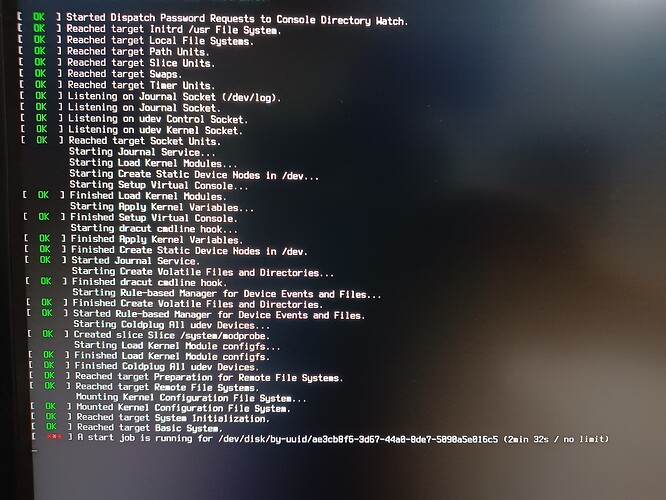Can we see the full contents of /boot/grub/grub.cfg
That would be
# DO NOT EDIT THIS FILE
#
# It is automatically generated by grub-mkconfig using templates
# from /etc/grub.d and settings from /etc/default/grub
#
### BEGIN /etc/grub.d/00_header ###
insmod part_gpt
insmod part_msdos
if [ -s $prefix/grubenv ]; then
load_env
fi
if [ "${next_entry}" ] ; then
set default="${next_entry}"
set next_entry=
save_env next_entry
set boot_once=true
else
set default="0"
fi
if [ x"${feature_menuentry_id}" = xy ]; then
menuentry_id_option="--id"
else
menuentry_id_option=""
fi
export menuentry_id_option
if [ "${prev_saved_entry}" ]; then
set saved_entry="${prev_saved_entry}"
save_env saved_entry
set prev_saved_entry=
save_env prev_saved_entry
set boot_once=true
fi
function savedefault {
if [ -z "${boot_once}" ]; then
saved_entry="${chosen}"
save_env saved_entry
fi
}
function load_video {
if [ x$feature_all_video_module = xy ]; then
insmod all_video
else
insmod efi_gop
insmod efi_uga
insmod ieee1275_fb
insmod vbe
insmod vga
insmod video_bochs
insmod video_cirrus
fi
}
if [ x$feature_default_font_path = xy ] ; then
font=unicode
else
insmod part_gpt
insmod ext2
search --no-floppy --fs-uuid --set=root ae3cb8f6-3d67-44a0-8de7-5090a5e016c5
font="/usr/share/grub/unicode.pf2"
fi
if loadfont $font ; then
set gfxmode=auto
load_video
insmod gfxterm
set locale_dir=$prefix/locale
set lang=en_US
insmod gettext
fi
terminal_input console
terminal_output gfxterm
if [ x$feature_timeout_style = xy ] ; then
set timeout_style=menu
set timeout=5
# Fallback normal timeout code in case the timeout_style feature is
# unavailable.
else
set timeout=5
fi
### END /etc/grub.d/00_header ###
### BEGIN /etc/grub.d/10_linux ###
menuentry 'Arch Linux' --class arch --class gnu-linux --class gnu --class os $menuentry_id_option 'gnulinux-simple-ae3cb8f6-3d67-44a0-8de7-5090a5e016c5' {
load_video
set gfxpayload=keep
insmod gzio
insmod part_gpt
insmod ext2
search --no-floppy --fs-uuid --set=root ae3cb8f6-3d67-44a0-8de7-5090a5e016c5
echo 'Loading Linux linux ...'
linux /boot/vmlinuz-linux root=UUID=ae3cb8f6-3d67-44a0-8de7-5090a5e016c5 rw nowatchdog nvme_load=YES loglevel=3
echo 'Loading initial ramdisk ...'
initrd /boot/intel-ucode.img /boot/initramfs-linux.img
}
submenu 'Advanced options for Arch Linux' $menuentry_id_option 'gnulinux-advanced-ae3cb8f6-3d67-44a0-8de7-5090a5e016c5' {
menuentry 'Arch Linux, with Linux linux' --class arch --class gnu-linux --class gnu --class os $menuentry_id_option 'gnulinux-linux-advanced-ae3cb8f6-3d67-44a0-8de7-5090a5e016c5' {
load_video
set gfxpayload=keep
insmod gzio
insmod part_gpt
insmod ext2
search --no-floppy --fs-uuid --set=root ae3cb8f6-3d67-44a0-8de7-5090a5e016c5
echo 'Loading Linux linux ...'
linux /boot/vmlinuz-linux root=UUID=ae3cb8f6-3d67-44a0-8de7-5090a5e016c5 rw nowatchdog nvme_load=YES loglevel=3
echo 'Loading initial ramdisk ...'
initrd /boot/intel-ucode.img /boot/initramfs-linux.img
}
menuentry 'Arch Linux, with Linux linux (fallback initramfs)' --class arch --class gnu-linux --class gnu --class os $menuentry_id_option 'gnulinux-linux-fallback-ae3cb8f6-3d67-44a0-8de7-5090a5e016c5' {
load_video
set gfxpayload=keep
insmod gzio
insmod part_gpt
insmod ext2
search --no-floppy --fs-uuid --set=root ae3cb8f6-3d67-44a0-8de7-5090a5e016c5
echo 'Loading Linux linux ...'
linux /boot/vmlinuz-linux root=UUID=ae3cb8f6-3d67-44a0-8de7-5090a5e016c5 rw nowatchdog nvme_load=YES loglevel=3
echo 'Loading initial ramdisk ...'
initrd /boot/intel-ucode.img /boot/initramfs-linux-fallback.img
}
}
### END /etc/grub.d/10_linux ###
### BEGIN /etc/grub.d/20_linux_xen ###
### END /etc/grub.d/20_linux_xen ###
### BEGIN /etc/grub.d/25_bli ###
if [ "$grub_platform" = "efi" ]; then
insmod bli
fi
### END /etc/grub.d/25_bli ###
### BEGIN /etc/grub.d/30_os-prober ###
### END /etc/grub.d/30_os-prober ###
### BEGIN /etc/grub.d/30_uefi-firmware ###
if [ "$grub_platform" = "efi" ]; then
fwsetup --is-supported
if [ "$?" = 0 ]; then
menuentry 'UEFI Firmware Settings' $menuentry_id_option 'uefi-firmware' {
fwsetup
}
fi
fi
### END /etc/grub.d/30_uefi-firmware ###
### BEGIN /etc/grub.d/35_fwupd ###
### END /etc/grub.d/35_fwupd ###
### BEGIN /etc/grub.d/40_custom ###
# This file provides an easy way to add custom menu entries. Simply type the
# menu entries you want to add after this comment. Be careful not to change
# the 'exec tail' line above.
### END /etc/grub.d/40_custom ###
### BEGIN /etc/grub.d/41_custom ###
if [ -f ${config_directory}/custom.cfg ]; then
source ${config_directory}/custom.cfg
elif [ -z "${config_directory}" -a -f $prefix/custom.cfg ]; then
source $prefix/custom.cfg
fi
### END /etc/grub.d/41_custom ###
Can you share a picture of what you see when it fails to boot?
Chroot into your system, uncomment the following line in /etc/default/grub:
From this:
#GRUB_ENABLE_CRYPTODISK=y
To this:
GRUB_ENABLE_CRYPTODISK=y
Then regenerate grub:
grub-mkconfig -o /boot/grub/grub.cfg
Then reboot and see if you get prompted for a passphrase to unlock your root partition.
Same result
Do the same again and try changing this line.
From this:
GRUB_CMDLINE_LINUX_DEFAULT="nvme_load=YES rw root=UUID=ae3cb8f6-3d67-44a0-8de7-5090a5e016c5"
To this:
GRUB_CMDLINE_LINUX_DEFAULT="nvme_load=YES rw rd.luks.uuid=ae3cb8f6-3d67-44a0-8de7-5090a5e016c5"
Then regenerate grub:
grub-mkconfig -o /boot/grub/grub.cfg
Reboot again, any changes?
That was already changed to nowatchdog nvme_load=YES loglevel=3" earlier, which appears to be ok because the grub.cfg gets the right uuid in the menuentry.
does this time out and take you to a prompt?
I let it run for half an hour earlier. Continues seemingly indefinitely.
I installed a vm to compare it to your grub config and installer uses " rd.luks.uuid= in the grub config. What files are in /etc/dracut.conf.d?
Hmm, might be worth a try then. Also, nothing. It’s empty.
That is only for encrypted installs. I don’t see anything indicated that this install is encrypted.
That isn’t normal. We deploy config there and so does the dracut package.
Yeah the coin just dropped, for some reason because of it being stuck at the root partition job I thought it was an encrypted partition. I guess it was a really long day. ![]()
Don’t worry. It’s currently 4:28am for me ![]() Tired is the only state to be in when fixing bugs.
Tired is the only state to be in when fixing bugs.
In the vm I installed there are two files, one for encryption which isn’t the case as you just made me realize and this file.
cat /etc/dracut.conf.d/eos-defaults.conf
omit_dracutmodules+=" network cifs nfs brltty "
compress="zstd"
Maybe add that and then run dracut -f
You can undo what I said here then, since I here I still though it was an encrypted device you were booting from.
dracut -f returns
dracut: Cannot find module directory /lib/modules/6.1.9-arch1-2/
dracut: and --no-kernel was not specified
Not sure what to make of that first one, since I updated earlier today so everything vital should be there and good.
Don’t use dracut -f, use dracut-rebuild
